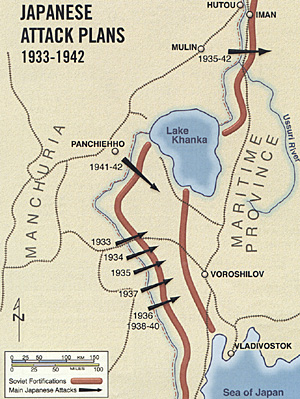 The Japanese gave much thought on
campaign planning against the Soviet Union.
Since the 1920's, the Kwantung Army plan was
revised annually as part of the IJA`s yearly
update to its overall operational plans. The plan
in existence in 1941 was actually a carryover
from the Imperial General Headquarters' Fiscal
Year 1940 operational plan for operations
against the Soviet Union. Like earlier plans, it
envisioned that the main effort would be made
in eastern Manchuria against the Soviet
Maritime province and that only a delaying
action would be conducted in the northern and
western parts of Manchuria.
The Japanese gave much thought on
campaign planning against the Soviet Union.
Since the 1920's, the Kwantung Army plan was
revised annually as part of the IJA`s yearly
update to its overall operational plans. The plan
in existence in 1941 was actually a carryover
from the Imperial General Headquarters' Fiscal
Year 1940 operational plan for operations
against the Soviet Union. Like earlier plans, it
envisioned that the main effort would be made
in eastern Manchuria against the Soviet
Maritime province and that only a delaying
action would be conducted in the northern and
western parts of Manchuria.
Once Soviet forces had been destroyed in the Maritime Province, the Kwantung Army would attack to the north and west and occupy a line running from Rukhlovo down to the western Greater Hsingan Mountains. For this ambitious undertaking, 32 divisions were allocated for the initial phase with another 10-11 reinforcing divisions pulled from China and Japan. The total of 42 or 43 divisions was a far greater force than the some 22 divisions the Kwantung Army was actually presented with in September 1941.
While the Japanese intent to attack into the Soviet Maritime Province from eastern Manchuria never changed, the actual sector from which the attack was to be launched changed several times. By 1941, the area west of Panchiehho was selected for the main effort to penetrate Soviet border fortifications (see map, pg. 8).
The selection of this point was made possible by the completion of a railway nearby and was necessitated by the strengthening of Soviet defenses elsewhere on the border. Completion of the same railway running up to the border fortress of Hutou also prompted the Japanese to plan to use a five division force from the area of Hulin to cross the Ussuri River to cut the Trans-Siberian railway. This was designed to split the Soviet forces defending the border with eastern Manchuria. These forces would then attack to the south to support the Panchiehho attack.
Of the 32 divisions planned to be committed in the initial phase of operations, fully 20 were allocated for the attack out of eastern Manchuria with only eight divisions covering the expanse of western and eastern Manchuria. Four divisions were held in general reserve.
Following the initial phase of operations during which Soviet border defenses would be penetrated and the bulk of Soviet forces in the Maritime Province destroyed, Japanese second phase operations would focus on the preparations to seize the fortress of Vladivostok. Elsewhere, Soviet forces would be mopped-up as the Kwantung Army advanced to the line of Rukhlovo to the Greater Hsingan Mountains. The forces in western and northern Manchuria assigned to delay a Soviet attack would be reinforced depending on where the Soviet attack took place.
Holding operations in the west were seen as particularly difficult and something which could affect the overall campaign. Over the years, the Japanese strengthened border troops in the area, built-up Hailar as a fortress, and planned to commit additional reinforcements into the area.
An important component of the campaign plan was the accompanying air campaign. At the commencement of hostilities, the Second Air Group was to launch surprise attacks on enemy airfields. Facilities in the area of Vladivostok and Khabarovsk were targeted. Attacks against targets in Vladivostok were to be supported by the Naval Air Force, including carrierbased aircraft.
After gaining air superiority, Japanese air forces were tasked to support the Kwantung Army while preventing the reconstitution of Soviet air power. Lines of communications, principally the TransSiberian Railroad, were also targeted to prevent the Soviets from shifting forces to assist in the decisive battle in the Maritime Province.
North Wind Rain Japanese Invasion of Manchuria
- Introduction and Background
The Nomohan Incident
Preparations for the Next Round
Japanese 1941 Campaign Plan
Into 1942 and Beyond
Kwantung Army Close Up
The Soviets Prepare
The Red Army and the Far East
The Red Army in 1942
Opposing Air Forces
Red Army Rifle Division April 1941 TO&E
Red Army Rifle Division July 1942 TO&E
Red Army Rifle Brigade July 1942 TO&E
Red Army Tank Brigade July 1942 TO&E
Red Army Far Eastern Front June 1941
Red Army Trans-Baikal Military District June 1941
Large Map: Kwangtung Army Deployment August 1941 (slow: 116K)
Jumbo Map: Kwangtung Army Deployment August 1941 (very slow: 397K)
Alternative History: 2nd Russo-Japanese War
Back to Table of Contents -- Against the Odds vol. 2 no. 1
Back to Against the Odds List of Issues
Back to MagWeb Magazine List
© Copyright 2003 by LPS.
This article appears in MagWeb.com (Magazine Web) on the Internet World Wide Web.
Other articles from military history and related magazines are available at http://www.magweb.com
* Buy this back issue or subscribe to Against the Odds direct from LPS.
